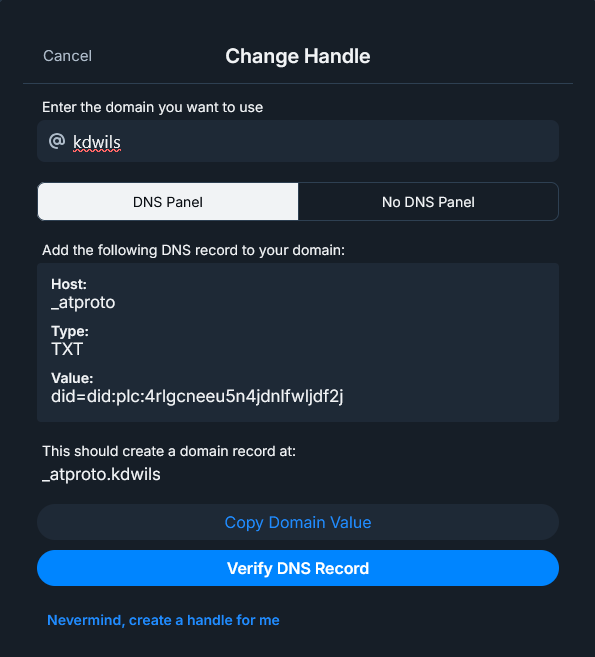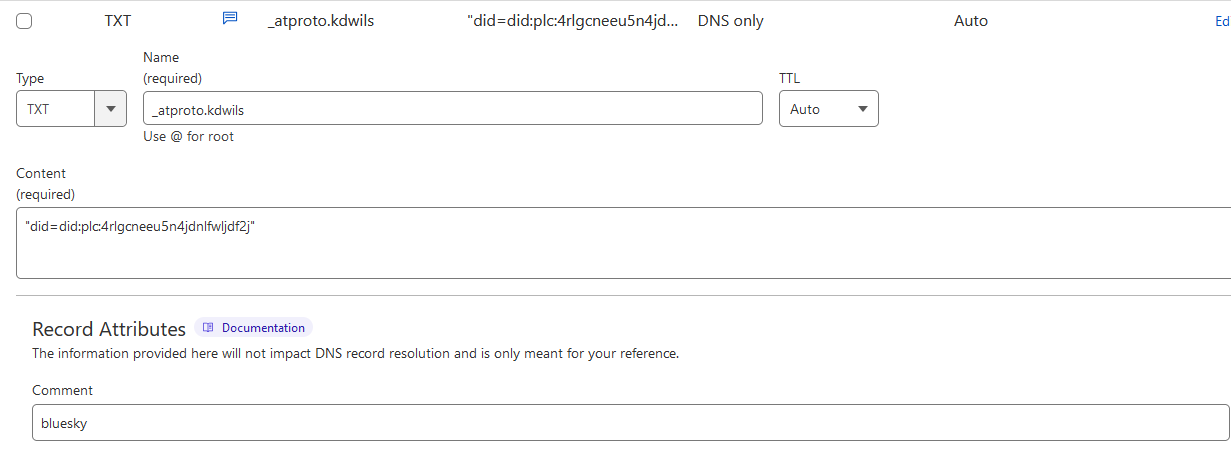Getting started
For those looking for the YAML configuration, here’s the repository: https://github.com/kdwils/homelab/tree/main/apps/bluesky.
Bluesky documentation (I’m assuming you already found this): https://github.com/bluesky-social/pds?tab=readme-ov-file#self-hosting-pds
Bluesky is another flavor of twitter/x (jack dorsey twitter v2), and allows you to self host a decentralized server that allows manage your social media data independently. Naturally, as someone who self hosts and occasionally tweets, this seemed like a cool thing to run on my kubernetes homelab.
I decided to write this post to help others looking to self-host in a similar environment
Kubernetes Caveats
The Docker image officially supplied by Bluesky doesn’t ship with the pdsadmin CLI, which makes the GitHub tutorial a little more awkward to follow if you’re planning to host on Kubernetes.
We can get around this by making rpc calls to the self hosted server.
Manifest
There are a few resources we need to create to host the server. I use Kustomize and a raw manifest approach.
Service and (optionally) a service account.. pretty standard so far. The server is exposed on port 3000 in the container.
apiVersion: v1
kind: ServiceAccount
metadata:
name: bluesky
---
apiVersion: v1
kind: Service
metadata:
name: bluesky
spec:
type: ClusterIP
ports:
- port: 3000
targetPort: pds-port
protocol: TCP
name: pds-port
selector:
app.kubernetes.io/name: bluesky
The deployment has the meat of the manifest
apiVersion: apps/v1
kind: Deployment
metadata:
name: bluesky
spec:
strategy:
type: Recreate
replicas: 1
selector:
matchLabels:
app.kubernetes.io/name: bluesky
template:
metadata:
labels:
app.kubernetes.io/name: bluesky
spec:
serviceAccountName: bluesky # optional
securityContext: {}
containers:
- name: bluesky
securityContext: {}
image: bluesky
imagePullPolicy: IfNotPresent
env:
- name: PDS_HOSTNAME
value: bluesky.kyledev.co
- name: PDS_JWT_SECRET
valueFrom:
secretKeyRef:
name: "bluesky"
key: jwtSecret
- name: PDS_ADMIN_PASSWORD
valueFrom:
secretKeyRef:
name: "bluesky"
key: adminPassword
- name: PDS_PLC_ROTATION_KEY_K256_PRIVATE_KEY_HEX
valueFrom:
secretKeyRef:
name: "bluesky"
key: plcRotationKey
- name: PDS_EMAIL_SMTP_URL
valueFrom:
secretKeyRef:
name: "bluesky"
key: smtpServer
- name: PDS_EMAIL_FROM_ADDRESS
valueFrom:
secretKeyRef:
name: "bluesky"
key: smtpFromAddress
- name: PDS_DATA_DIRECTORY
value: "/pds"
- name: PDS_BLOBSTORE_DISK_LOCATION
value: "/pds/blocks"
- name: PDS_DID_PLC_URL
value: "https://plc.directory"
- name: PDS_BSKY_APP_VIEW_URL
value: "https://api.bsky.app"
- name: PDS_BSKY_APP_VIEW_DID
value: "did:web:api.bsky.app"
- name: PDS_REPORT_SERVICE_URL
value: "https://mod.bsky.app"
- name: PDS_REPORT_SERVICE_DID
value: "did:plc:ar7c4by46qjdydhdevvrndac"
- name: PDS_CRAWLERS
value: "https://bsky.network"
- name: LOG_ENABLED
value: "true"
ports:
- name: pds-port
containerPort: 3000
protocol: TCP
volumeMounts:
- name: data
mountPath: /pds
livenessProbe:
httpGet:
path: /xrpc/_health
port: pds-port
resources:
limits:
cpu: 300m
memory: 512Mi
requests:
cpu: 100m
memory: 128Mi
volumes:
- name: data
persistentVolumeClaim:
claimName: "bluesky"
Environment variables on the container
Turn logging on in the container:
- name: LOG_ENABLED
value: "true"
Defaults provided in the installion script:
- name: PDS_DATA_DIRECTORY
value: "/pds"
- name: PDS_BLOBSTORE_DISK_LOCATION
value: "/pds/blocks"
- name: PDS_DID_PLC_URL
value: "https://plc.directory"
- name: PDS_BSKY_APP_VIEW_URL
value: "https://api.bsky.app"
- name: PDS_BSKY_APP_VIEW_DID
value: "did:web:api.bsky.app"
- name: PDS_REPORT_SERVICE_URL
value: "https://mod.bsky.app"
- name: PDS_REPORT_SERVICE_DID
value: "did:plc:ar7c4by46qjdydhdevvrndac"
- name: PDS_CRAWLERS
value: "https://bsky.network"
The hostname of the server that is public-facing on the internet:
- name: PDS_HOSTNAME
value: bluesky.kyledev.co
Generating secret values
The others are tied to secrets because they container sensitive data.
The PDS_JWT_SECRET and PDS_ADMIN_PASSWORD can be generated by taking a look at the installation script and running the same command.
Hold onto your admin password for later.
You’ll need to run this for twice, once for the PDS_JWT_SECRET, and once again for the PDS_ADMIN_PASSWORD
openssl rand --hex 16
- name: PDS_JWT_SECRET
valueFrom:
secretKeyRef:
name: "bluesky"
key: jwtSecret
- name: PDS_ADMIN_PASSWORD
valueFrom:
secretKeyRef:
name: "bluesky"
key: adminPassword
The key for rotation can be generated using the following command from the installation script.
openssl ecparam --name secp256k1 --genkey --noout --outform DER | tail --bytes=+8 | head --bytes=32 | xxd --plain --cols 32
- name: PDS_PLC_ROTATION_KEY_K256_PRIVATE_KEY_HEX
valueFrom:
secretKeyRef:
name: "bluesky"
key: plcRotationKey
The SMTP server
For account verification, the PDS server needs to send emails. I used my Google account to handle this.
Here is a reference to start with: https://support.google.com/accounts/answer/185833?hl=en
Look for Create and manage your app passwords. Create an app password, and copy the code. It should look something like:
abcd efgh ijkl mnop
Creating the secret
These values can be encoded on unix systems with the following command
echo -n '<value-here>' | base64
For example, this command should output bXktdmFsdWU=
echo -n 'my-value' | base64
The secret to be created should look like the following:
apiVersion: v1
data:
adminPassword: <base64 encoded value>
jwtSecret: <base64 encoded value>
plcRotationKey: <base64 encoded value>
smtpFromAddress: <base64 encoded value>
smtpServer: <base64 encoded value>
kind: Secret
metadata:
name: bluesky
namespace: bluesky
type: Opaque
Do NOT check this into source code management. I used bitnami’s sealed-secrets operator.
With this, you encrypt the secret locally, check the CRD into git, and then the CRD is decrypted in the cluster by the operator to create a normal secret resource.
Data persistence
You need somewhere for blue sky to store data and the sqlite file it uses for a database. I use longhorn.
I gave the PVC a starting storage of 20Gi. I’m not sure if this is overkill, or underkill.
kind: PersistentVolumeClaim
apiVersion: v1
metadata:
name: "bluesky"
spec:
accessModes:
- ReadWriteOnce
resources:
requests:
storage: 20Gi
Using the server
Once deployed and running in kuberentes, we can start the account sign up process, but we first need to expose our server to the world. Do this at your own risk. I prefer to use cloudflare tunnels.
Exposing our PDS server
I use Cloudflare tunnels to expose services outside of my Kubernetes cluster. To learn how to do the same, check out my previous post.
Add the ingress config for the PDS server. Here is an example of the format my cloudflared deployment config uses.
ingress:
- hostname: bluesky.kyledev.co
service: http://bluesky.bluesky.svc.cluster.local:3000
Add the DNS record using the cloudflared CLI.
cloudflared tunnel route dns <your-tunnel-name> <your-bluesky-host>
One problem with using cloudflared tunnels is verifying your email address. I ran into issues mentioned in these github issues and was running on version https://github.com/bluesky-social/pds/issues/100 https://github.com/bluesky-social/pds/issues/106
I ended up exposing the PDS server through my tailnet and making the RPC call to send the verification email that way. I copy pasted the http request from my browser and used the my tailnet domain instead.. hacky but it worked. The comments in these issues suggested editing the DB itself which I did not want to do. I was also using image version 2024.11.0.
Generating an invite code
curl -X POST 'https://<your-bluesky-host>/xrpc/com.atproto.server.requestEmailConfirmation' \
--header 'Content-Type: application/json' \
--data-raw '{"useCount": 1}' \
--user 'admin:<your-admin-token>'
This should spit out a code like bluesky-<host>-<tld>-xxxxx-xxxxx. Sign up for a bluesky account using your domain and invite code. You can do this via phone app or web app.
Verifying our domain and handle
Once you do this, we need to next verify our domain and handle. I did this by creating a TXT record under my domain for bluesky to use.
Navigate to Settings -> Change handle -> I have my own domain on your bluesky account.

Next, in cloudflare, I followed the provided instructions and created a TXT record.

You can verify using this debug tool if needed to ensure you DNS record is working https://bsky-debug.app/handle
And we’re live…

Anyway, here’s a shameless plug: https://bsky.app/profile/kdwils.kyledev.co for a follow. Yell at me here if this doesn’t work for you.